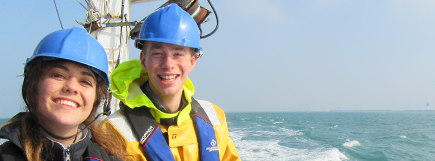Data Management
Code UE : HBB370
- Cours + travaux pratiques
- 3 crédits
- Volume horaire de référence
(+ ou - 10%) : 30 heures
Responsable(s)
Claire MARION
Public, conditions d’accès et prérequis
Entry requirements
Good knowledge of mathematics, physics and English
Relationship to other courses:
HB300 – Information technology
HB310 – navigation
HB340 – Tides and currents
HB350 – Geodesy & cartographic systems
HB360 – Hydrographic surveying
HB380 – Geology & cartographic systems
HB390 – Legal aspect
HB500 – Hydrographic practice
Good knowledge of mathematics, physics and English
Relationship to other courses:
HB300 – Information technology
HB310 – navigation
HB340 – Tides and currents
HB350 – Geodesy & cartographic systems
HB360 – Hydrographic surveying
HB380 – Geology & cartographic systems
HB390 – Legal aspect
HB500 – Hydrographic practice
Objectifs pédagogiques
Module Outline:
?
- ANALOGUE DATA CAPTURE
- Manual input of alphanumeric data
- Raster scanning processes and vector digitisation
- Description of digitising systems and scanners
- Georeferencing of paper maps
- Description of digital data formats
- Digital data transfer exercises
- DATA MANAGEMENT, PROCESSING AND ANALYSIS????
- Approximation and estimation procedures for survey measurements
- The concepts of Geographical Information Systems (GIS)
- The properties of spatial databases and Database Management Systems (DBMS)
- The concepts of raster and vector data, gridded and meshed models (including TINs)
- Spatial data selection algorithms: filtering, smoothing, approximation, estimation, correlation and analysis
- Digital Elevation Models (DEMs)
- MARINE GIS
- The use of Geographical Information Systems (GIS) within the marine environment and their use in areas such as coastal zone management
- Graphic presentation of data from marine data bases
- Data and metadata management and nautical charting
- The electronic charting concept as a special form of GIS
- DATA PRESENTATION
- Cartographic semiology, colour theory and schemes, shading and illumination techniques
- Manual and automatic plotting and contouring of hydrographic data: resolution, scale and vertical exaggeration
- The use of vector and raster digitising and plotting systems
- Hydrographic applications of 3D modelling and visualisation
- MARINE CARTOGRAPHY
- Chart compilation process and flow line
- Application in the production flow of the instructions of the General Bathymetric Chart of the Oceans (GEBCO):
- Nautical charting & production; Chart Compilation
- Assessing and maintaining data quality throughout the compilation process
- COASTAL TOPOGRAPHY & MAPPING
- GNSS-based and ground survey techniques to delineate coastline and attached cultural features
- Coastline map creation with aerial photographs
- The use of Ground photography in the depiction of coastline topography
- Relation between tidal datums and charted shorelines
- PUBLICATIONS
- Required hydrographic data for navigational publications (including tide tables, sailing directions, light lists, radio aids to navigation, port guides, and notice to Mariners)
- CHART PRODUCTION / REPRODUCTION OF ANALOGUE MAPS
- The process of creating chart plates from graphic products and from digital files
- Production of the Chart out of multiple plates
- DIGITAL MAPS
?
- CORRECTION OF CHARTS
- The importance of updating nautical charts and the dissemination of chart corrections
- The responsibilities of each element in the sequence from surveyor to mariner
- Obtaining latest information and checking for old data
Compétences visées
Learning Outcomes:
- To be able to create the required data types, part of a standard exchange format and to configure systems for secure storage, transfer and backup of survey data.
- To be able to use data cleaning techniques using appropriate software, while distinguishing between noise, outliers and real features as well as assessing propagated errors of survey data.
- Applying procedures used to assess, accept and reject data.
- Being able to apply spatial data processing techniques to create DTMs or gridded surfaces and contouring, as well as applying estimation procedures to assess survey measurements and volume computations.
- To explain the concepts of Spatial Data Infrastructures (SDIs); raster and vector data models.
- To be able to use file types that support the exchange of hydrographic data to transfer data between acquisition, database and GIS environments.
- Explain the concept and use of GIS within the marine environment.
Contenu
Lecture 1 Analog data capture
Lecture 2 Management, processing and analysis of spatial data
Lecture 3 Marine GIS
Lecture 4 Data presentation
Lecture 5 Marine Cartography
Lecture 6 Coastal Topography & Mapping
Lecture 7 Publications
Lecture 8 Chart Production / Reproduction of Analogue Maps
Lecture 9 Digital Maps
Lecture 10 Correction of Charts
Lecture 2 Management, processing and analysis of spatial data
Lecture 3 Marine GIS
Lecture 4 Data presentation
Lecture 5 Marine Cartography
Lecture 6 Coastal Topography & Mapping
Lecture 7 Publications
Lecture 8 Chart Production / Reproduction of Analogue Maps
Lecture 9 Digital Maps
Lecture 10 Correction of Charts
Modalité d'évaluation
Evaluation
Evaluation form
Written examination, partly with multiple choice, partly with open questions.
Fieldwork – permanent evaluation of the practical exercises
Assessment methodology
The final figure of assessment is composed of:
50% (written examination)
50% (permanent evaluation)
Assessment criteria
Permanent evaluation: this evaluation is based upon the training record book in relation to the number of tasks carried out and the comments of the supervisor(s) expressed in written in the book; workshops: proof of attendance: reports, exercises.
Theory examination: quality of knowledge, insight, relation between subjects, …
Evaluation form
Written examination, partly with multiple choice, partly with open questions.
Fieldwork – permanent evaluation of the practical exercises
Assessment methodology
The final figure of assessment is composed of:
50% (written examination)
50% (permanent evaluation)
Assessment criteria
Permanent evaluation: this evaluation is based upon the training record book in relation to the number of tasks carried out and the comments of the supervisor(s) expressed in written in the book; workshops: proof of attendance: reports, exercises.
Theory examination: quality of knowledge, insight, relation between subjects, …
Cette UE apparaît dans les diplômes et certificats suivants
Rechercher une formation
CRITERES
- Le champ Mot-clé permet de rechercher les formations grâce à un mot ou à une expression présent dans l’intitulé ou dans les index d’une formation.
Des index vous sont suggérés à partir du 3e caractère saisi, mais vous pouvez aussi saisir librement tout autre chaîne de caractères . - les différents items sélectionnés sont croisés.
ex: "Comptabilité" et "Région Alsace"
CODE
- Vous pouvez utiliser le caractère joker * pour remplacer un nombre quelconque de caractères
- UE : le code comprend 3 lettres immédiatement suivies de 3 chiffres
- Certificat : le code comprend 2 ou 3 lettres immédiatement suivies de 3 chiffres. Certains certificats se déclinent selon plusieurs parcours :
- pour afficher le tronc commun, tapez le code simple (ex : LG005).
- pour afficher un parcours précis dans un diplôme, faites suivre le code de la lettre "p", et du numéro de parcours (ex : LG005p2). Si le diplôme ne comporte qu'un seul parcours, faites suivre la lettre "p" de -1 (ex : CYC17p-1).
Dans tous les cas, veillez à ne pas insérer d'espace ou de ponctuation supplémentaire.
Chargement du résultat...

Intitulé de la formation |
Type |
Modalité(s) |
Lieu(x) |
|
|---|---|---|---|---|
Intitulé de la formation
Bachelor océanographe prospecteur
|
Lieu(x)
Initial
|
Lieu(x)
Paris
|
||
| Intitulé de la formation | Type | Modalité(s) | Lieu(x) |
Contact
Voir le calendrier, le tarif, les conditions d'accessibilité et les modalités d'inscription dans le(s) centre(s) d'enseignement qui propose(nt) cette formation.
Enseignement non encore programmé
Code UE : HBB370
- Cours + travaux pratiques
- 3 crédits
- Volume horaire de référence
(+ ou - 10%) : 30 heures
Responsable(s)
Claire MARION












